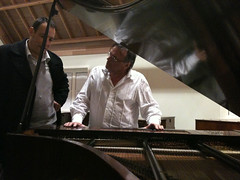A conversation on the parallels between music and leadership reveals quite some blind spots. And I’ll let you guess on which of both sides. What worries me most is that these blind spots are too obvious to be true.
It is an exceptionally wet and cloudy day here in Belgium as Dominique and I meet Jos van Immerseel, the Flemish harpsichordist, pianist and conductor of the renowned Anima Eterna Brugge ensemble. As facilitators of BiZZarts (where art meets business) we are particularly interested in the parallels between music and leadership. Both art forms are a few thousand years old. Yet, putting them together reveals surprising insights.
The Curse of Partial Knowledge
We find Jos on his knees in front of a harpsichord, as he apologizes for the work in progress: fixing a string. According to van Immerseel this is essential for every musician: knowing your instrument from the inside out and being able to fix it. Unfortunately this skill has become very rare. This is the starting point for a small exploration of a maestro’s mind:
As a conductor it is important to have a feeling for the possibilities and constraints of an instrument. A violin, a harpsichord or an oboe; each instrument has specific characteristics that a conductor needs to be aware of.
But there is a danger here for a conductor: having partial knowledge over the characteristics of an instrument – even up to the point of mastering it – is the greatest pitfall of a conductor. At a certain point a conductor may become very intrusive with regards to how a musician needs to play the instrument. Most of the times, this game ends in sheepish musicians playing their scores without any passion. The perfectionist instructions of the conductor ripped their passion away, and the musicians switch off.

Dominique and Jos van Immerseel (click to enlarge)
No Man’s Land
The question then is, how should one – as a conductor – make sure to get the best out of a musician? Here, van Immerseel sets clear boundaries to what he calls his domain of action:
I need to guard the harmony and should only step in whenever the consonance is at stake. From there on the musician should determine whether the root cause is in the instrument or elsewhere.
But that’s not all. The interesting part is that this boundary creates a no man’s land: a space where none of them is in charge. This is a space where dialog is needed between conductor and musician. They put their observations together and work out a solution.
I need to trust the musician to find the cause of the dissonance that I am signaling.
This requires fostering a good dialogue and relationship with the musicians, rather than full expertise and control over each individual instrument involved.
Passion and Memory
Whereas Ben Zander claims to spot passion in the way people’s eyes are shining, Jos van Immerseel has developed a more down-to-earth detector of passion in musicians:
A good orchestra has the memory of an elephant. If I need to explain the story, the backgrounds and the objectives of our project all over each Monday morning, week after week, that’s when I know there is a lack of passion.
Passion is the element that focuses a musician. With passion they are able to navigate through the tsunami of information that is coming at them during a rehearsal.
In an earlier article Jef Staes uncovered the relationship between Passion and Information overload. Surprisingly they both come to the same conclusion: Passion is the key ingredient to navigate information.
Tuning of the Instruments
It sounds too trivial to write it even down in this article: the reason why musicians tune their instruments in a orchestra is to find the balance in the performance. Their purpose is to create resonance in what the orchestra is performing. In the setting of an orchestra, not tuning the instruments would be unthinkable.
It would result in a dissonant cacophony of sounds, even if each individual musician is playing like a virtuoso.
But in business how many times do our virtuoso managers and team members tune their instruments before kicking off a project or a million dollar investment? It seems like tuning of the instruments in business is not done once you play on a certain level. The more skilled musicians are in business life, you will be less likely to find them tuning their instruments before they kick off.
I could be wrong, but the dissonant results from certain multimillion dollar projects may turn out to be avoidable if we gave ‘tuning of the instruments’ a proper place in management.
Rehearsing
On an equal level of triviality, not rehearsing is unthinkable for a good performance. Yet it is difficult to think of an equivalent in business terms.
There are two ways one can approach rehearsing and we can see the difference when we look at the French and the German word for rehearsal:
– In French we talk about ‘répétition‘, i.e.: the repeating the performance, over and over again – without transforming or improving what is happening (and mostly without thinking);
– In German, the word is ‘Proben‘, which is more related to modeling and the setting up of landmarks.
The most important thing about rehearsing though, is the fact that both, the conductor and the musician, are discovering these landmarks together and at the same time. A lot of the knowledge that is needed in order to set the landmarks exists in the no man’s land. The basic assumption is that both the conductor and the musicians are the experts in charge of their own field. Yet, when they need give a performance together, they need to travel alongside in this territory and set the landmarks.
The Curse of Interpretation
Jos van Immerseel makes a final note on the way ‘interpretation’ has become mainstream. It seems to be trendy to say that a conductor or an ensemble has taken the work of a composer to the next level with a so-called contemporary interpretation. Unfortunately, those well applauded interpretations are an offense against the composer’s intent:
When you have a look at the scores of a Beethoven piece, the precision and intent can’t be overlooked. Ignoring those notes is like building a house and at the same time neglecting the architect’s measures and sidenotes on materials.
Monteverdi is a completely different example. There we see almost no extra information with regards to the intent. But that is not an excuse to improvise. My job as a conductor is then to study the era in which it was written, the exact wording of the opera texts and most of all: what exactly this music meant when it was created. As it turns out, Monteverdi brought a revolution to the music scene by putting the music instruments in service of the human voice for the first time. Until then, polyphony was the standard. Without Monteverdi rock and pop music as we know it (instruments supporting the voice of a singer) would simply not exist.
It is clear that van Immerseel has a definition of excellence that adheres to that of management guru Tom Peters (‘Excellence or Nothing’) and shares a sense of ‘Divine Discontent’ of that other guru Ram Charan:
Conductors who fail to see how revolutionary Monteverdi was at his time, the groundbreaking importance of retorics in that era or the exact meaning of singer’s texts, could hide this lack of homework with a layer of interpretation. But the truth is that interpretation is often a fancy way to hide incompetence.
Disconcerting Conclusions for Business
This evening with Jos van Immerseel was a wonderful and enchanting walk though the world of music, but to the same extent it was a disconcerting experience for the art form that I am a practitioner of: management.
I am left with the following questions:
- How could management improve if our instruments would be tuned before a performance?
- How often do we crush passion with partial knowledge?
- Do we invade No Man’s land by being right or do we use it as an environment for relationship to occur?
- What are the landmarks we are after for a good performance?
- How often are we hiding a lack of homework behind the label of interpretation?
I have no clue about the answers, but at least now I know what I am after.




Pingback: Luc’s Thoughts on Organizational Change » Music and Leadership (part 6)()